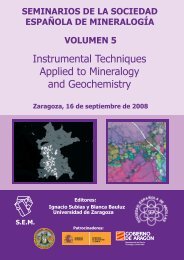XVI Reunión CientÃfica de la Sociedad Española de Arcillas - Libro ...
XVI Reunión CientÃfica de la Sociedad Española de Arcillas - Libro ...
XVI Reunión CientÃfica de la Sociedad Española de Arcillas - Libro ...
Create successful ePaper yourself
Turn your PDF publications into a flip-book with our unique Google optimized e-Paper software.
Franco F et al. / Comunicaciones SEA 2001 – Baeza (Jaén)<br />
en el espectro <strong>de</strong>l complejo K-H muestra diferencias notables con el<br />
comportamiento que se acaba <strong>de</strong> <strong>de</strong>scribir. Este calentamiento no permite <strong>la</strong><br />
regeneración completa <strong>de</strong> <strong>la</strong> banda 1 <strong>de</strong> <strong>la</strong> caolinita y causa un notable aumento<br />
en <strong>la</strong> intensidad <strong>de</strong> <strong>la</strong>s bandas B y C, <strong>la</strong>s cuales persisten tras <strong>la</strong> <strong>de</strong>saparición <strong>de</strong><br />
<strong>la</strong>s bandas <strong>de</strong> vibración características <strong>de</strong> <strong>la</strong> hidracina y <strong>de</strong>l agua.<br />
El calentamiento <strong>de</strong>l complejo K-H en pastil<strong>la</strong> <strong>de</strong> PTFE reve<strong>la</strong> que <strong>la</strong><br />
intensidad <strong>de</strong> <strong>la</strong> banda 1 es restaurada alre<strong>de</strong>dor <strong>de</strong> 90 ºC al mismo tiempo que<br />
<strong>la</strong> intensidad <strong>de</strong> <strong>la</strong> banda a ∼ 3450 cm -1 (banda D) <strong>de</strong>crece consi<strong>de</strong>rablemente. El<br />
<strong>de</strong>scenso c<strong>la</strong>ro en intensidad <strong>de</strong> <strong>la</strong> banda más característica <strong>de</strong> <strong>la</strong> hidracina<br />
(banda E) se observa, en cambio, a partir <strong>de</strong> 100 ºC y no afecta a <strong>la</strong> intensidad<br />
<strong>de</strong> <strong>la</strong> banda 1. Así, en esta serie <strong>de</strong> espectros, el <strong>de</strong>scenso en intensidad <strong>de</strong> <strong>la</strong><br />
banda 1, al formar el complejo, podría re<strong>la</strong>cionarse con <strong>la</strong> formación <strong>de</strong> en<strong>la</strong>ces<br />
<strong>de</strong> hidrógeno entre <strong>la</strong>s molécu<strong>la</strong>s <strong>de</strong> agua interca<strong>la</strong>da y <strong>la</strong> superficie <strong>de</strong> OH <strong>de</strong> <strong>la</strong>s<br />
capas <strong>de</strong> caolinita. A<strong>de</strong>más, estos espectros no muestran <strong>la</strong>s bandas nuevas A,<br />
B y C, lo que <strong>de</strong>muestra c<strong>la</strong>ramente que estas bandas <strong>de</strong>ben ser atribuidas<br />
interacciones entre el KBr y el complejo <strong>de</strong> interca<strong>la</strong>ción.<br />
Referencias<br />
Farmer VC (1974) En: Infrared spectra of minerals (VC Farmer ed). Mineral Soc,<br />
London: 331-359.<br />
Frost RL, Kristóf J, Paroz GN, Kloprogge JT (1998) J Coll Interf Sci 208: 216-225.<br />
Johnston CT, Stone DA (1990) C<strong>la</strong>ys C<strong>la</strong>y Miner 38: 121-128.<br />
Ledoux RL, White JL (1966) J Coll Interf Sci 21: 127-152.<br />
Recibido el 24 <strong>de</strong> julio <strong>de</strong> 2001<br />
Aceptado el 31 <strong>de</strong> agosto <strong>de</strong> 2001













